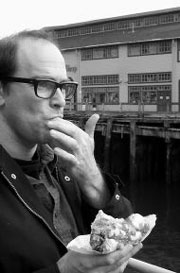“SEATTLE FILM DIRECTOR” is basically an oxymoron, since those who want to make something more substantial (and expensive) than a short movie soon leave town for Hollywood. Not so with Capitol Hill’s Gregg Lachow, who moved here as a playwright but now grudgingly admits, “I call myself a filmmaker.” Certainly the soft-spoken 42-year-old New York native has earned the right, having created four pictures here since arriving in 1988: The Seven Mysteries of Life (1994), The Wright Brothers (1997), Money Buys Happiness (1999), and Silence!, which premiered at SIFF last May.
SILENCE!
directed by Gregg Lachow runs April 11-12 at Little Theatre
In fact, Lachow and the cast of Silence! are headed to L.A., but it’s for his career retrospective at the prestigious American Cinematheque. Before the road trip, Silence! runs here with a script Lachow says has been substantially rewritten since SIFF. Still, its hybrid nature is the same: While a silent black-and-white movie plays on the screen, performers onstage variously narrate, comment, lip-synch, and even dance to the filmed proceedings. (The music’s also live.) Lachow and his writers incorporate two texts into Silence!: Delmore Schwartz’s 1937 short story In Dreams Begin Responsibilities, in which a man imagines he’s watching a movie about his parents’ courtship, and Chekhov’s The Cherry Orchard—which the Silence! onscreen movie crew comically attempts to film.
Uh-oh, you’re asking, is this some kind of wonky theater exercise in deconstruction?
“First of all, I think people are going to see a film,” says Lachow reassuringly. “I call it a ‘performed film.’ I think of it as a manifestation of a kind of hidden truth, which is that a film is different every time you see it. Obviously it’s physically the same, but we’ve all had the experience of it being dramatically different based on . . . the circumstances in which we see it. Because not only are you sitting and watching the film, but you’re watching the people watching the film.”
Live music and performance were often part of silent-era cinema exhibition, he notes. “There’s evolution in art forms, and certainly the evolution of film is one of the more interesting, in that there are various branches . . . that went only so far and died.” Silence! speaks to what Lachow calls the subsequent “forced marriage between picture and sound” (analogous to the Delmore Schwartz material).
Speaking to the flesh-and-blood theatricality that’s also been squeezed out of modern (talking) Hollywood cinema, Lachow concludes, “Another thing that goes on with Silence! is . . . the idea that if you want to see this film you have to go to the movie theater. You can only see it as part of the community. It can’t be rented.”








